|

by Emel Akan
August 04, 2025
from
TheEpochTimes ebsite
Article also HERE
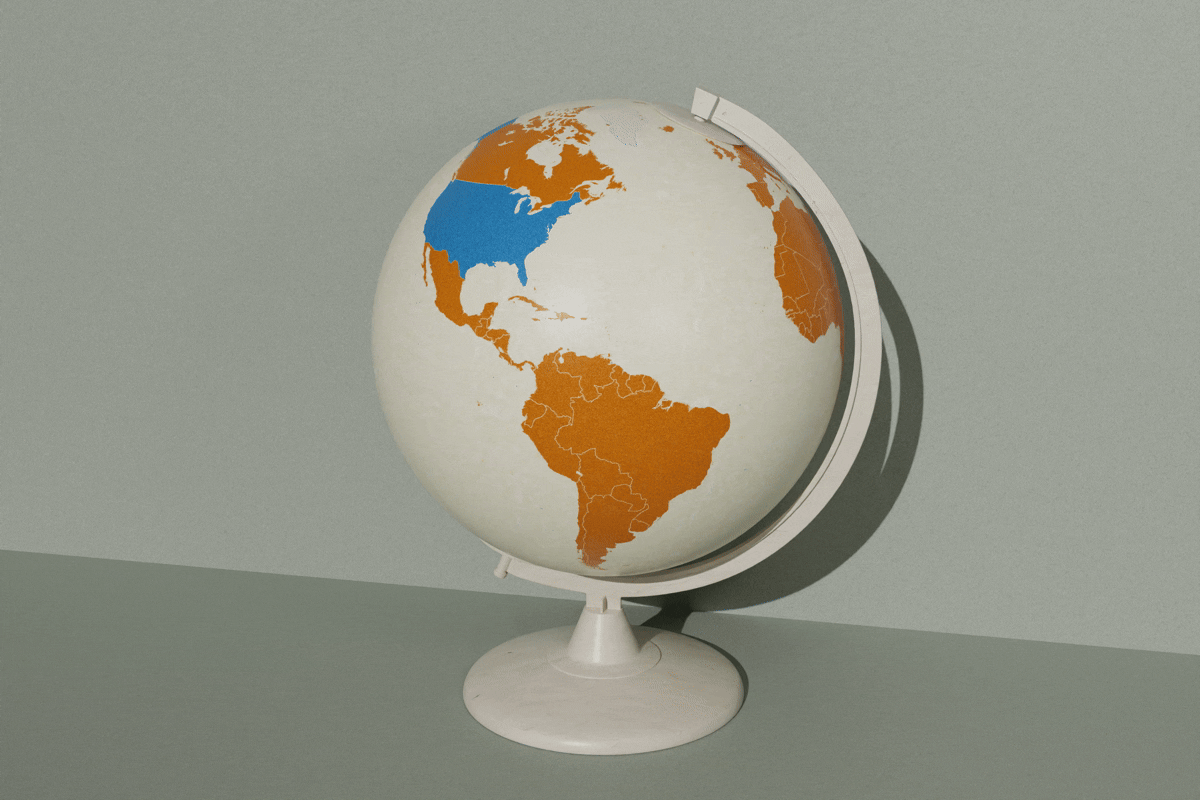
Illustration
by The Epoch
Times
Trump is leveraging tariffs
to broker
peace, restructure global trade,
and secure
concessions from
U.S.
allies and rivals...
WASHINGTON
In his second term, President
Donald Trump has reshaped U.S.
foreign policy,
using tariffs not just as economic leverage
but as a central tool of diplomacy...
His administration has leveraged economic
pressure to address global conflicts and secure concessions from
other nations, marking one of the most significant shifts in U.S.
foreign policy in decades.
Just months after taking office, Trump made clear of his ambitions,
stating that his second term would be very different from his first.
"The first time, I had two things to do - run
the country and survive; I had all these crooked guys. And the
second time, I run the country and the world," he told The
Atlantic in an April interview.
Trump has touted how his tariff strategy -
resulting in trade concessions from allies such as the European
Union and South Korea, along with breakthroughs in conflicts - is
evidence that the new foreign policy approach is delivering results.
His trade threats have already helped end several conflicts,
including the recent border skirmish between Thailand and Cambodia
and the crisis between India and Pakistan.
On June 27, Trump hosted the foreign ministers of the Democratic
Republic of Congo and Rwanda to the White House as they
signed a peace deal to end their 30-year war.
Michael Walsh, senior fellow in the Africa program at the
Foreign Policy Research Institute, said the White House has
demonstrated that it can promote regional stability through economic
incentives.
"They believe very strongly that if you can
show countries that they have an economic incentive to not fight
with one another and to work with one another and work with the
United States, that you can resolve a lot of conflicts in the
world," Walsh told The Epoch Times.
Walsh said Trump's approach in Africa, which
prioritizes trade over aid, has been more effective than the
strategy pursued by former administrations.
The Trump administration is continuing its engagement in Africa, now
turning its attention to conflict in Sudan, which is often labeled
the "forgotten war," in which an
estimated 150,000 people have died,
according to data reported by the Council on Foreign Relations
(CFR).
Although no breakthrough has been achieved so
far, Walsh said Sudan and other parts of Africa remain a priority
for U.S. peace efforts.
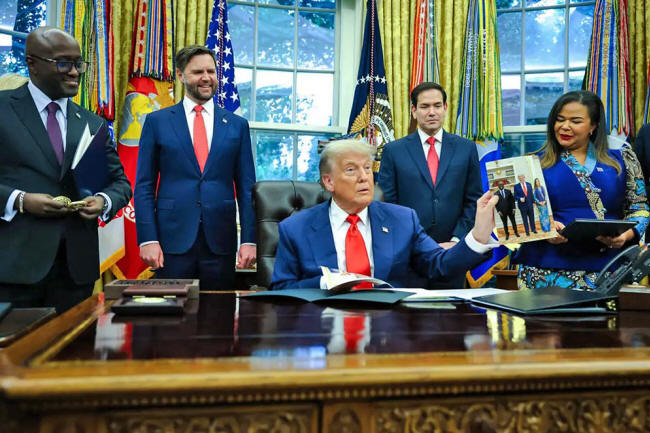
U.S. President Donald Trump holds
a photo as he meets with
Minister of
Foreign Affairs and Cooperation of Rwanda Olivier Nduhungirehe
and the Foreign
Minister of the Democratic Republic of the Congo
Thérèse
Kayikwamba Wagner
in the Oval
Office on June 27, 2025.
The meeting
followed a peace deal brokered by the White House
and signed by
officials from both nations to end the conflict in eastern Congo.
The
administration is seeking to utilize economic incentives
to help foster
regional stability.
Joe Raedle/Getty
Images
Tariffs may Weaken Russia, BRICS
Most recently, Trump is pressuring China and
India to stop purchasing sanctioned Russian oil as part of
his effort to weaken the Kremlin and end its
war in Ukraine.
On Aug. 1, Trump took to Truth Social to criticize
Moscow over the rising death toll in both Russia and Ukraine.
"This is a War that should have never
happened," he wrote.
"I'm just here to see if I can stop it!"
The Trump administration is leveraging tariffs in
negotiations with China and India to isolate Russia, according to
Chris Tang, a professor at UCLA's Anderson School of Management,
who described the development as "a very
interesting dynamic."
If the strategy succeeds, it could drive Russia into economic
collapse, he told The Epoch Times.
Last month, Trump also targeted the
BRICS alliance - led by Brazil,
Russia, India, China, and South Africa - warning against their
efforts to challenge the U.S. dollar's global dominance.
"Any Country aligning themselves with the
Anti-American policies of BRICS, will be charged an ADDITIONAL
10 percent Tariff.
There will be no exceptions to this policy,"
he
stated on Truth Social.

A serviceman with Ukraine's 24th
Mechanized Brigade
fires a
howitzer at Russian forces near Chasiv Yar, Ukraine, on Nov. 18,
2024.
President
Donald Trump has begun pressuring China and India
to stop buying
sanctioned Russian oil in an effort to end the Kremlin's war in
Ukraine.
Oleg Petrasiuk/24th
King Danylo Separate Mechanized Brigade
of the
Ukrainian Armed Forces/File Photo/Handout via Reuters
In February, just weeks into his second term, Trump imposed 25
percent tariffs on goods from Canada and Mexico, and added a 10
percent levy on Chinese imports, to pressure these countries to
address fentanyl trafficking.
Most recently, he threatened Brazil with a 50 percent tariff on its
exports to the United States, sharing on Truth Social
a letter to Brazilian President
Luiz Inácio Lula da Silva.
In the letter, Trump accused Brazil of becoming
an "international disgrace" due to the ongoing trial of former
Brazilian President Jair Bolsonaro, a close Trump ally.
Trump's tariff strategy is already showing results. In June, Canada
backed off its plan to implement a 3 percent digital services tax on
large tech firms after Trump halted trade talks and threatened to
impose higher tariffs on Canadian imports.
The U.S. government has
collected more than $150 billion in
tariff revenue over the past six months, according to the White
House.
The Congressional Budget Office in June
projected that figure could grow to $2.8 trillion over the next
decade...
Keith Krach, who served as under secretary
of State for economic growth, energy and the environment in the
first Trump administration, said Trump is using tariffs as a broader
strategy to rewire global trade and secure America's dominance on
the world stage.
"President Trump has always viewed tariffs as
a strategic tool," Krach told The Epoch Times.
"In his first term, he used them like a
scalpel - targeting steel, aluminum, and specific trade gaps.
Now, tariffs are the linchpin of his economic statecraft."
Key Concessions
Many analysts argue that the strength of Trump's tariff strategy
stems from America's economic and military power.
As the world's largest economy and consumer
market, the United States can exert pressure in a way that
others can't.
This leverage was evident in recent negotiations
with the European Union.
While Trump initially proposed a 30 percent
tariff, the EU ultimately agreed to a 15 percent rate, still a sharp
rise from the previous average of 4.8 percent, according to World
Trade Organization
data.
The White House
said the new tariffs on European
goods would,
"generate tens of billions of dollars in
revenue annually."
In addition, the bloc agreed to
invest $600 billion in the United
States over the course of Trump's term and purchase $750 billion of
U.S. energy exports over three years.
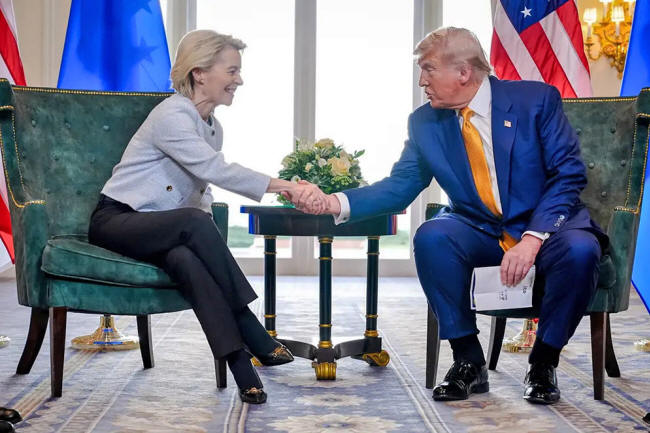
U.S. President Donald Trump
and European
Commission President Ursula von der Leyen
shake hands
after reaching a trade deal,
at the Trump
Turnberry golf course
in
Turnberry, Scotland, on July 27, 2025.
Under the deal,
the United States
will impose 15
percent tariffs on EU exports,
and the bloc
will buy $750 billion in American energy
and invest $600
billion in the United States by 2028.
Jacquelyn
Martin/AP Photo
U.S. Treasury Secretary Scott Bessent called it,
"the deal of the century," and European
Commission President
Ursula von der Leyen called
it "a huge deal."
"It will bring stability, it will bring predictability. That's
very important for businesses on both sides of the Atlantic,"
von der Leyen said.
However, some other European leaders reacted
strongly against the deal.
French Prime Minister François Bayrou
stated on X that,
the trade deal was "a dark day" for the EU
and a "submission" to Trump.
Marine Le Pen, the leader of France's
right-wing National Rally party, condemned the agreement as a,
"political, economic, and moral fiasco."
Meanwhile, German Chancellor Friedrich Merz
warned that,
"the German economy will suffer considerable
damage as a result of these tariffs."
Japan similarly
agreed to a 15 percent tariff and
pledged $550 billion investment in the U.S. economy, with the United
States set to receive 90 percent of the profits from those projects.
Under the latest deal with South Korea, exports to the
United States will face a 15 percent tariff, while U.S. goods
entering South Korea will be exempt from any tariffs.
In addition, Seoul committed to investing $350 billion in the United
States and purchasing $100 billion worth of American liquefied
natural gas, crude oil, and coal.
On July 31, Trump signed an executive order establishing
reciprocal tariff rates for dozens of countries.
However, several nations, including Mexico,
Canada, India, and China,
have yet to finalize agreements with the Trump administration.
Kevin Hassett, director of the White House National
Economic Council, said,
the administration has already secured trade
deals with eight key trading partners, covering "about 55
percent of world GDP."

Kevin Hassett,
director of the
White House National Economic Council,
walks
toward the West Wing at the White House on June 30, 2025.
Hassett said
Beijing continues to fall short of its commitments
on rare-earth
shipments, despite recent increases.
Andrew
Caballero-Reynolds/AFP via Getty Images
These trade deals are largely settled, though there may still be
some "dancing around the edges" on specific terms, Hassett
told NBC News' "Meet the Press" on
Aug. 3.
Countries that don't have finalized agreements, will soon face
"reciprocal rates," with further negotiations expected to continue,
he noted.
The Trump administration has also announced a new 40 percent tariff
on
transshipments, a tariff-avoidance
tactic that primarily involves Chinese goods being minimally altered
or simply relabeled in other countries and then sent to the United
States.
The United States has already secured
commitments from some countries,
including Vietnam, to block the influx of cheap
Chinese products into their markets for transshipment.
So far, this overhaul of U.S. tariff policy has not triggered broad
retaliation from major trading partners, although the United States
and China are still negotiating after tit-for-tat tariffs were
paused.
"President Trump is seizing the moment to
reset the rules of the game. I give him high marks. His strategy
is already producing impressive results," Krach said.
"No one has exploited our generosity more
than China."
Philip Luck, director of the economics
program at the Center for Strategic and International Studies,
said Trump has managed to roll out his strategy,
"without triggering widespread retaliation
from trading partners."
"This success in avoiding retaliation likely stems from credible
signaling of 'escalation dominance' - essentially convincing
partners that entering a cycle of economic retaliation would be
more costly for them than for the United States," Luck wrote in
a recent report with Ina Simonovska.
Tariffs Reshape Supply Chains
Trump has long championed tariffs to revive American manufacturing
and boost domestic jobs.
But according to Tang,
reshoring jobs to the country remains
difficult after decades of industrial decline, a shortage of
skilled labor, and ongoing infrastructure and regulatory
hurdles.
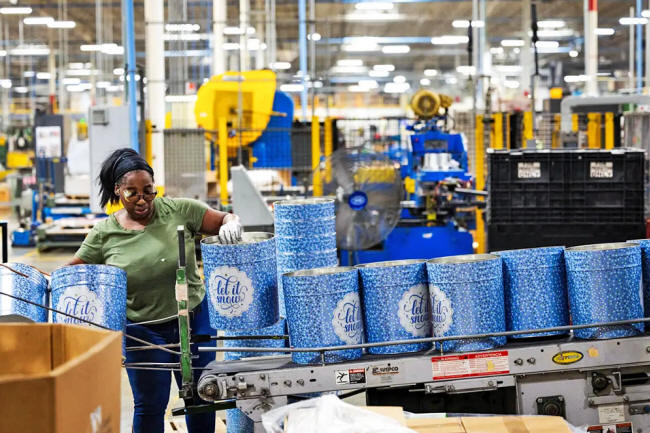
An employee of Independent Can
Company
works on the
manufacturing line in Belcamp, Md., on June 25, 2025.
President
Donald Trump has long championed tariffs
to revive
American manufacturing and boost domestic jobs.
Experts warn
that reshoring remains difficult after decades
of industrial
decline, labor shortages, and regulatory challenges.
Ryan Collerd/AFP
via Getty Images
Some companies are relocating production to the United States to
avoid tariffs and serve the domestic market.
However, many still depend on cheaper overseas
labor for international sales, creating a split in global supply
chains.
"For domestic consumption goods, a lot of
companies will gradually produce more in the United States,"
Tang said.
"But for the international market, the United
States still relies on emerging markets with lower labor costs."
He cited Eli Lilly as an example, noting the
pharmaceutical giant plans to produce more of its weight-loss drugs
in the United States, because the domestic market is the largest.
"It makes sense for the company to produce
here," Tang said.
Industries such as pharmaceuticals and
semiconductors are leading the reshoring trend due to their
highly automated production processes, which reduce labor needs.
Automakers such as Volkswagen are also ramping up
their U.S. investment to avoid Trump's tariffs.
Still, bringing entire automotive supply
chains to America remains a challenge.
Even with tariffs, high labor costs make
countries like Mexico and China more attractive for some parts of
the supply chain, Tang said.
Despite several recent trade wins, Trump still
faces unresolved battles, including a new trade agreement and an
ongoing standoff with China over rare-earth minerals.
While Chinese rare-earth shipments have surged in
recent weeks, Beijing is still falling short of its commitments,
according to Hassett.
"In the last month, there's been a big, big
increase, but I think that we're all still hoping for more,"
Hassett told The Epoch Times on July 30.
White House officials continue to push for
reducing U.S. dependence on processed rare earths from China by
supporting domestic investments, but,
"it will take a few years to get there," Tang
said.
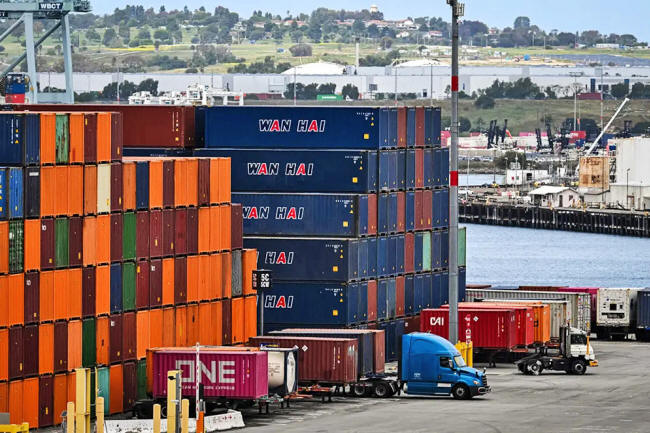
Cargo containers sit stacked at
the Port of Los Angeles
in San Pedro,
Calif., on April 15, 2025.
The Trump
administration faces ongoing trade disputes,
including
tensions with China over rare-earth minerals,
as it pushes to
reduce U.S. reliance on Chinese supply
through
domestic investment.
Patrick T.
Fallon/AFP via Getty Images
Uncertainty Remains
While Trump has secured a series of trade victories,
questions remain about their long-term durability.
Many of the tariff measures are based on executive authority and
could be reversed by future administrations. Additionally,
enforcement of major investment commitments by trading partners is
still unclear.
One example is,
Trump's trade deal with the EU, which
includes a pledge from Brussels to purchase $750 billion in U.S.
energy over three years.
However, analysts are skeptical.
In 2024, U.S. energy exports to the EU totaled
$78.5 billion - far below what would be needed to meet the
commitment.
The bigger challenge, according to a recent report by investor and
minerals researcher John Zadeh, is whether the United States
can scale up exports to roughly $250 billion annually between 2025
and 2028.
"The critical limitation facing U.S.
exporters isn't production capacity but rather export
infrastructure," Zadeh explained.
"Particularly for natural gas, the process of
liquefaction and marine terminal loading creates bottlenecks
that cannot be quickly overcome, regardless of how much gas is
produced domestically."
Von der Leyen backed the agreement, saying
the EU would,
"replace Russian gas and oil with significant
purchases of U.S. LNG, oil, and nuclear fuels."
Business leaders are also cautiously supportive
of Trump's trade deals.
The Business Roundtable, an association of more
than 200 CEOs of America's leading companies, praised Trump's
efforts to restore balance in trade and support U.S. manufacturing,
but warned of risks.
"We are concerned that persistent high tariff
rates will harm the U.S. economy, especially the manufacturing
sector," the group
said, urging continued negotiations to lower tariffs and
non-trade barriers.
Meanwhile, the market reaction to the 15 percent
tariffs on key trading partners such as the EU and Japan has been
largely muted. Investors have so far shrugged off concerns about the
tariffs' potential impact on the U.S. economy and inflation.
The S&P 500 has rebounded more than 25 percent
since its April 8 low, suggesting that markets may have initially
overreacted to the April 2 unveiling of the tariffs.
|








